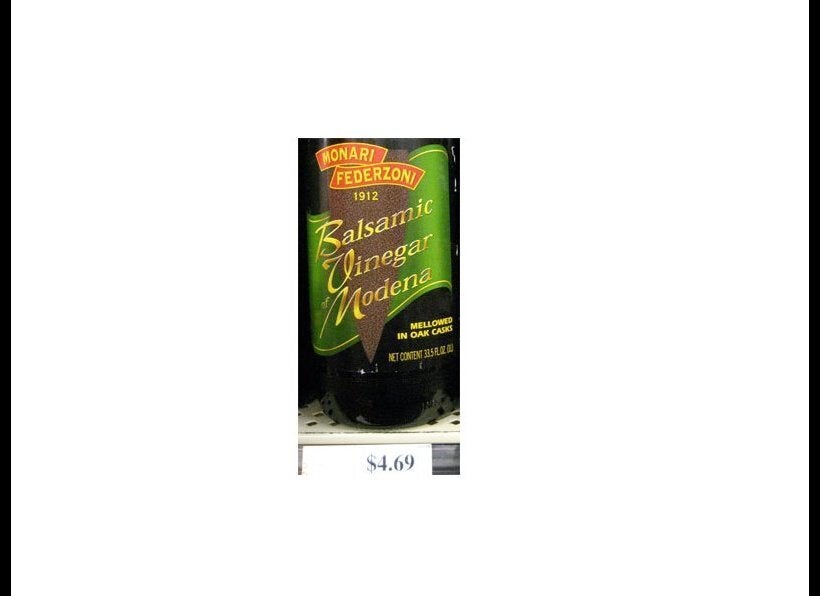Read more recipes, techniques, tips, and reports from Meathead's kitchen and grill deck at AmazingRibs.com
 A decade ago only restaurant chefs knew about balsamic vinegar, and today the most mundane supermarkets stock several brands as well as a growing selection of balsamic vinegar salad dressings. You can buy it in bulk from some olive oil specialty stores, and every Italian restaurant worth it's spaghetti offers an item or three made with balsamic. Chefs and foodies consider balsamic as essential as extra virgin olive oil. But the price for a bottle ranges from $5 to $500. How can that be? What is the difference?
A decade ago only restaurant chefs knew about balsamic vinegar, and today the most mundane supermarkets stock several brands as well as a growing selection of balsamic vinegar salad dressings. You can buy it in bulk from some olive oil specialty stores, and every Italian restaurant worth it's spaghetti offers an item or three made with balsamic. Chefs and foodies consider balsamic as essential as extra virgin olive oil. But the price for a bottle ranges from $5 to $500. How can that be? What is the difference?
Alas, there is not an easy answer, and if one goes to Modena, Italy, the small town where it was invented and where most of it is still made, answers are not much easier to find. Raise the question in a local wine bar and a fight might break out. And forget trying to learn about the subject on the internet. Inaccuracies are more common than facts on most websites.
That's because, in an attempt to improve quality and build a bigger market, four competing trade associations and seven regulatory bodies have emerged. And they don't get along. As a result, there are numerous labeling conventions, numerous methods of production, numerous claims of authenticity, and a boggling range of quality and price.
Bottom line: Nobody knows what balsamic vinegar really is. But if you sit down with a tall drink, or maybe a salad with Newman's Own Balsamic Vinaigrette Dressing, I can help you get a handle on things and help you get the most for your money.
Aceto Balsamico Tradizionale
Tradizionale is a far cry from what most of us have come to think is balsamic vinegar. It is dense and viscous, velvety, almost like a syrup when poured. It is shiny mahogany in the middle and sparkling amber along the edges. The perfume is penetrating but, even though it averages 6% acidity by weight, does not attack your sinuses and make you pull back like normal vinegars, and it is layered with floral and dried fruit essences. In the mouth it is velvety, slick, almost oily, like a liqueur, harmoniously sweet and tart at the same time, with a singular flavor of caramel, concentrated raisins, dried figs, dates, and cherries. When you swallow, it lasts longer than sex.
The exact methods differ slightly from producer to producer, but the general approach is the same. It begins by harvesting a variety of locally grown grapes, most prominently the white variety, trebbiano from the low hills around Castelvetro, crushing them, and then coarsely filtering the mash, called mosto. The mosto is then cooked (cotto) in an open vat at 175-200F for a day or two, reducing it to about half the volume.
The concentrated cotto mosto is then inoculated with a "mother of vinegar", a batch of vinegar alive with a culture of aceto-bacteria. They convert it to acetic acid, better known as wine vinegar. The ingredients list on the label is simple: Mosto d'uva cotto (literally "must of grapes cooked").
The vinegar begins aging in large wooden barrels and stored in the attic, yes, the attic, not the cellar, of the acetaia where the living liquid is subjected to the heat of summer and the freezing cold of winter.
The attic contains several lines of 5-10 barrels, called batteria, each decreasing in size, with the first one about 100 gallons, and the smallest about 10 gallons. Each barrel contains progressively older vinegar. Every winter about 25% of the vinegar in the smallest barrel is removed and bottled, and younger vinegar from the barrel next in line replaces it. This "topping up" siphoning cascade continues on up the line, with young vinegar replacing the older vinegar that has moved on down the line. The process is similar to the solera process used to make fine sherry in Spain.
The bung holes of the casks are not stoppered, only covered with gauze to keep dust and flies out, so over the course of a year about 10% evaporates. Called the "angels' share", this evaporation significantly reduces the amount of vinegar and concentrates the flavors of the remaining fluid. There are also significant losses to sediment that settles out with age.
In addition, each barrel is usually made from a different wood, among them oak, chestnut, cherry, mulberry, ash, and juniper. The acidity extracts unique flavors from each tree, conferring complexity to the end product. The initial casks are usually more porous wood, perhaps chestnut, to promote evaporation and concentration of the vinegar and the smaller casks, with the older vinegars, are made of harder wood such as oak.
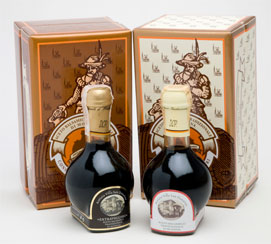 The finished vinegar is tasted by assagiatori, expert tasters, from the consorzio, the consortium, to which the acetaia belongs, and, if it passes, is bottled by the consorzio.
The finished vinegar is tasted by assagiatori, expert tasters, from the consorzio, the consortium, to which the acetaia belongs, and, if it passes, is bottled by the consorzio.
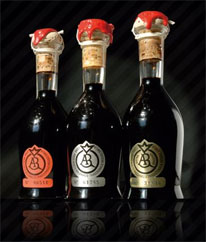 Reggio Emilia has a consorzio, and Modena has two who don't get along. Modena has a unique trademarked bottle shape, with a long neck, globe middle, and rectangular base, only 3.4 ounces (100 ml), shown at left. Reggio Emilia has a different trademarked bottle shape, like a bowling pin with a flared bottom, also 3.4 ounces, shown at right.
Reggio Emilia has a consorzio, and Modena has two who don't get along. Modena has a unique trademarked bottle shape, with a long neck, globe middle, and rectangular base, only 3.4 ounces (100 ml), shown at left. Reggio Emilia has a different trademarked bottle shape, like a bowling pin with a flared bottom, also 3.4 ounces, shown at right.
Tradizionale producers have attempted to grade their vinegars based on their ages. They speak of them as 12, 18, or 25 year old, and older. But remember, because younger vinegars are added to the smallest barrel each year, the actual age of the vinegar is impossible to know.
That's why, by law, tradizionale cannot be labeled with an age statement or a vintage date, and why you should be skeptical of any age statement you see on a label or in an advertisement.
In Modena, according to Consorzio Tra Produttori di Aceto Balsamico Tradizionale di Modena, the younger tradizionale, called affinato, is bottled with a white top, and the older one, which is often labeled extra vecchio, extra mature, has a gold top. In Reggio Emilia, according to Consorzio Produttori di Aceto Balsamico Tradizionale di Reggio Emilia, there are three grades, crimson top for affinato, silver top for a middle age called vecchio, and gold top for extra vecchio.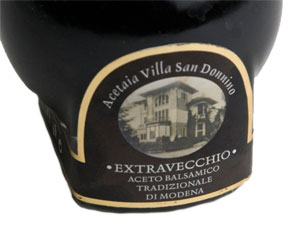 In case you're curious, there is another official body regulating tradizionale in Modena, the Consorzio Tutela Aceto Balsamico Tradizionale di Modena. It was formed in a dispute with the older Consorzio. Further explanations are not worth the effort.
In case you're curious, there is another official body regulating tradizionale in Modena, the Consorzio Tutela Aceto Balsamico Tradizionale di Modena. It was formed in a dispute with the older Consorzio. Further explanations are not worth the effort.
In Modena there are about 100 producers and they make at total of about 50,000 bottles per year and Reggio Emilia has about 60 producers who make 25,000 bottles per year. Of the 75,000 bottles total, about 40%, or 30,000 bottles, are extra vecchio.
Buying Guide. All the tradizionale vinegars I tasted were excellent and are highly recommended if you can afford them. They are subject to the law of diminishing returns as often applied to wine, the older extra vecchio is much more expensive than the affinato, and it is usually better, but is it worth the price? That's a matter of how wealthy you feel. I have seen affinato for as little as $100 on the internet, and extra vecchio typically is in the $200-500 range for a 3.4 ounce (100 ml) bottle. I have purchased direct from producers in Italy for significantly less, shipping included. Academia Barilla is one of the largest suppliers, and their vinegars are very good. Click here to check the price of their Affinato on Amazon. Click here to check the price on their Extra Vecchio. A word of caution: I have seen one producer, Delizia, marketing a "Traditional Style" Balsamic Vinegar. Although it is a nice vinegar, it is nowhere close to the real thing and its name would probably be illegal in Italy.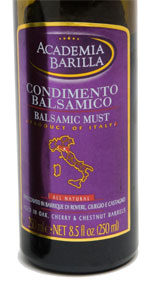
Condimento Balsamic or Balsamic Must
Buying Guide. The Academia Barilla is the only one I have seen in the US, and it is sold only in specialty stores. Click here to see the price of their Condimento Balsamico on Amazon.com.
Balsamic Vinegar di Modena
The problem is that some salad balsamic is watery and insipid tastes like crudely made fresh wine vinegar and smells like apple cider, banana, geraniums, and even solvent. These are not desirable characteristics. And the prices can get up to $50 per bottle. There's no sure way to tell from the bottle what you are getting, and that makes it hard to use in recipes.
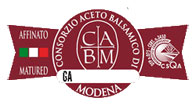 Beginning in 2001 some of the producers formed a consortium to improve quality and image, the Consorzio Aceto Balsamico di Modena (CABM). It has about 20 members, but their production and labeling rules are much less stringent than the tradizionale consortiums, and the methods of production vary widely. Sadly, the CABM doesn't do much to help consumers.
Beginning in 2001 some of the producers formed a consortium to improve quality and image, the Consorzio Aceto Balsamico di Modena (CABM). It has about 20 members, but their production and labeling rules are much less stringent than the tradizionale consortiums, and the methods of production vary widely. Sadly, the CABM doesn't do much to help consumers.
They came up with a red tag for the top of their bottles that supposedly certifies it has passed a taste test and spent three years barrels, and a white tag is supposed to certify that it has aged more than three years. But it's hard to be sure of that since the blending of vinegars in a batteria means that surely some of the vinegar is younger, and perhaps some is even older.
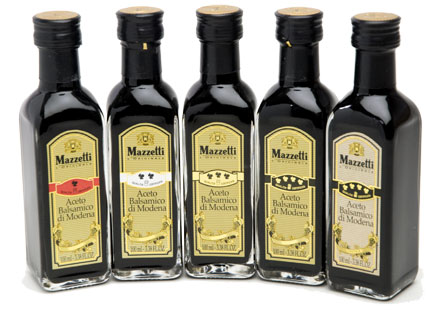 In 2001 yet another association came along, the Assaggiatori Italiani Balsamico (Italian Balsamic Vinegar Tasting Association). AIB instituted a rating system based on taste, but not all producers participate yet. If a vinegar has been submitted for tasting, a colored band is printed on the label with 1-4 grape leaves (shown at right). According to Fini, a leading producer, one leaf on a red band indicates a vinegar with "a classic flavor, light and slightly pungent, suitable for salads and everyday use." Two leaves on a silver band indicates a more syrupy consistency and "a smooth flavor, which matches well with grilled dishes and oven-roast vegetables." Three leaves on a gold band designates "a vinegar with a distinct, rounded, full flavor, ideal for meat and fish dishes and hot sauces." Four gold leaves on a black band are given to "an exceptionally dense condiment with a superb flavor, which comes from the ageing of the very best reserves: perfect for exclusive recipes, on fruit, ice-cream and with Parmigiano cheese."
In 2001 yet another association came along, the Assaggiatori Italiani Balsamico (Italian Balsamic Vinegar Tasting Association). AIB instituted a rating system based on taste, but not all producers participate yet. If a vinegar has been submitted for tasting, a colored band is printed on the label with 1-4 grape leaves (shown at right). According to Fini, a leading producer, one leaf on a red band indicates a vinegar with "a classic flavor, light and slightly pungent, suitable for salads and everyday use." Two leaves on a silver band indicates a more syrupy consistency and "a smooth flavor, which matches well with grilled dishes and oven-roast vegetables." Three leaves on a gold band designates "a vinegar with a distinct, rounded, full flavor, ideal for meat and fish dishes and hot sauces." Four gold leaves on a black band are given to "an exceptionally dense condiment with a superb flavor, which comes from the ageing of the very best reserves: perfect for exclusive recipes, on fruit, ice-cream and with Parmigiano cheese."
In my experience there is a quality difference as one adds grape leaves to the label of each producer, but there is no equivalence between producers. For example, the Fini four leaf is better than the one leaf, and the Mazetti 4-leaf is better than its one leaf, but the Fini four leaf is a lot better than the Mazetti four leaf.
 There are other bottles that have age claims on the label. They sell for a pretty penny, and some taste mighty nice, but because there is no rule regulating age statements, there's no guarantee that it really is that old and worth the price. One popular brand, de Nigris, which sells for about $25 for an 8.5 ounce bottle (250 ml), has a big 12 on the label, giving the impression that it is 12 years old. But the fine print behind the 12 says "star quality." One can only guess what "12 star quality" means.
There are other bottles that have age claims on the label. They sell for a pretty penny, and some taste mighty nice, but because there is no rule regulating age statements, there's no guarantee that it really is that old and worth the price. One popular brand, de Nigris, which sells for about $25 for an 8.5 ounce bottle (250 ml), has a big 12 on the label, giving the impression that it is 12 years old. But the fine print behind the 12 says "star quality." One can only guess what "12 star quality" means.
Bottom line: For now, if the label says Balsamic Vinegar di Modena or something similar, it's caveat emptor.
Some recipes with balsamico
Selecting balsamic
All text and photos are Copyright (c) 2010 By Meathead, and all rights are reserved

